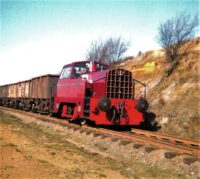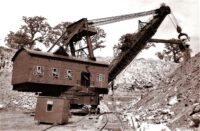The full programme for 2022 can now be found on our ‘What’s on and Events‘ page, admission fees for the Museum on both Fully Open Steam Days and on Viewing Days are also published.
Ironstone Quarry closure anniversaries feature large in museum’s events for 2022
Fifty years ago the excavation of ironstone for the manufacture of iron and steel came to an end at Market Overton Ironstone Quarry in Rutland in the East Midlands. Whilst quarrying ceased the site then became the focus of two railway preservation schemes, with one involving the world-famous steam locomotive “FLYING SCOTSMAN”. An exhibition on Market Overton’s Ironstone Quarries and preservation schemes will open at Easter and will run until the middle of October.
Ten years before, in 1962, the Burley Ironstone Quarry in Rutland ceased the excavation of ironstone in 1962 and a small display will summarise its history.
 Sentinel FRANK takes a train of iron ore tippler wagons into the workings at Market Overton Ironstone Quarry, Rutland . Photo courtesy Mr R Knight
Sentinel FRANK takes a train of iron ore tippler wagons into the workings at Market Overton Ironstone Quarry, Rutland . Photo courtesy Mr R Knight
The ironstone quarry at Storefield in Northamptonshire was one of the last ironstone quarries to operate steam locomotives until 1969. From 1969 until final closure in 1972 all rail traffic was handled by a diesel locomotive. A small display will summarise its history and the surviving diesel locomotive will be on display
Fifty five years ago in 1967 it came as something of a shock when the Oxfordshire Ironstone Quarries near Banbury were closed. Only a few years before their steam locomotives had been replaced by a fleet of 13 brand new diesel locomotives and the future looked bright. A small display will summarise its history whilst three of the surviving diesel locomotives will be on display.
The 700 ton Ransomes and Rapier 5360 electrically powered stripping shovel digging overburden in No.6 quarry at Market Overton, Rutland . Photo Courtesy. Mr G Taylor
The museum is home to steam locomotive “SINGAPORE”, which was captured by the Japanese along with 80,000 allied servicemen at the Fall of Singapore in 1942, some 80 years ago. Allied prisoners of war in the Far East had to endure 3 ½ years of captivity and hard labour under a harsh and uncaring Japanese occupation regime. Of those who were taken to work on the infamous Burma- Siam Death Railway, built through the disease infested jungle, one in four of the prisoners were not destined to survive. To mark the anniversary of the liberation of the allied prisoners of war in late August the museum will include the SINGAPORE locomotive in a special memorial display to be held on August Bank Holiday Sunday to the courage, comradeship and sacrifice of Far Eastern Prisoners of War 1941-1945.



